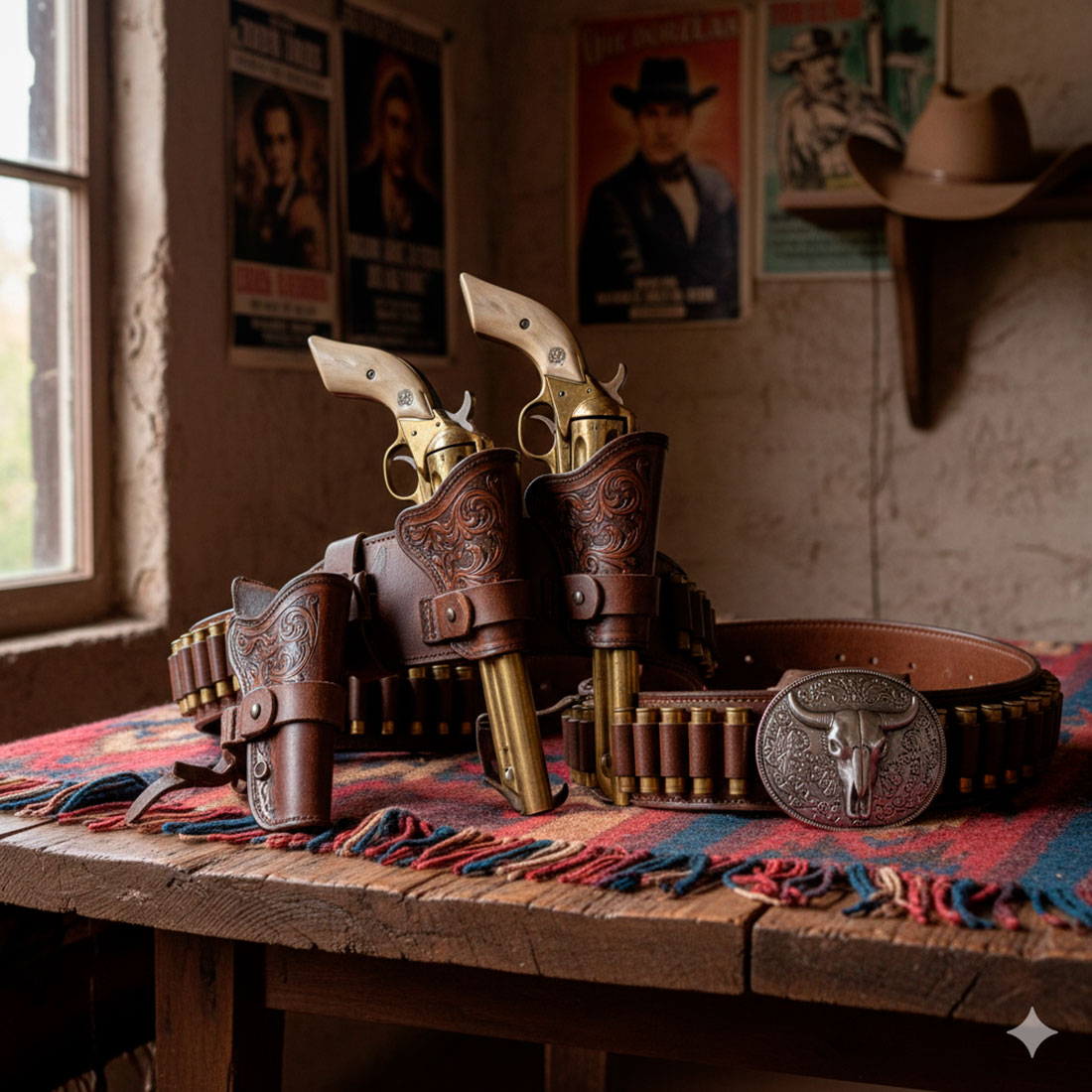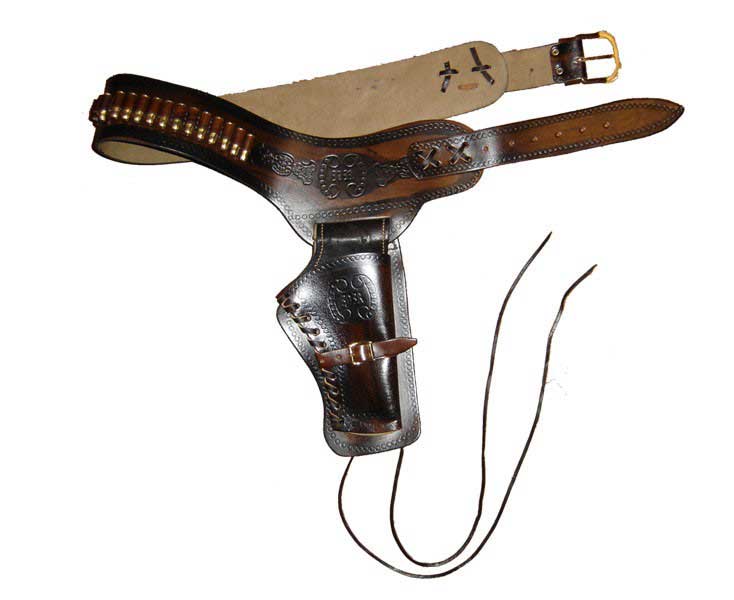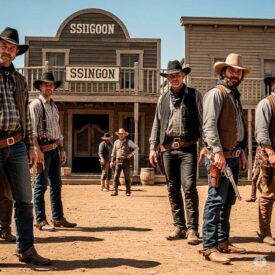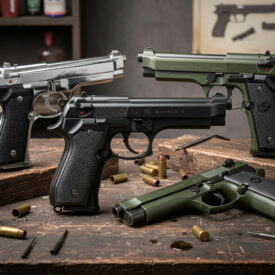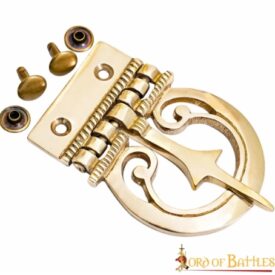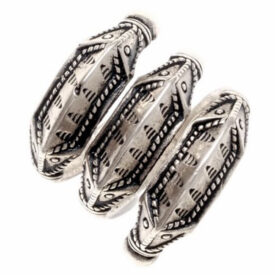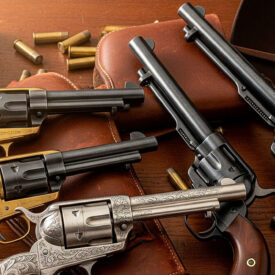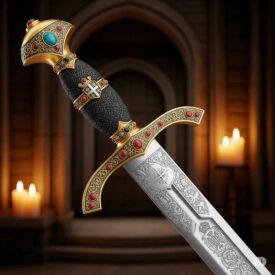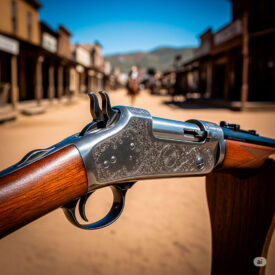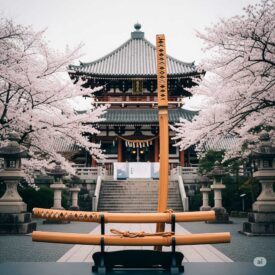Have you ever imagined the weight of ammunition on your waist as you cross a dusty town at noon? Revolver gunbelts were not just a practical accessory in the Old West: they were a symbol of preparedness, a distinctive element of the cowboy and gunslinger, and an essential piece of clothing that has been etched into our collective memory thanks to western films.
Today, revolver gunbelt replicas allow you to relive that golden age with astonishing accuracy. Manufactured with high-quality materials and faithful to original 19th-century designs, these holsters are much more than simple accessories: they are a window to the past, a way to connect with the history of the Wild West, and an indispensable complement for collectors, historical re-enactors, and western film lovers.
In this article, you will discover everything about revolver gunbelts: what makes them unique, how to choose the perfect replica, which historical models inspired the most iconic ones, and why they remain an essential item for any American West enthusiast.
What are revolver gunbelts and why are they so emblematic?
Revolver gunbelts are holsters specifically designed to carry ammunition for large-caliber revolvers, especially those used in the Old West between the years 1860 and 1899. Their characteristic design includes individual leather loops where cartridges are inserted, allowing quick and secure access to ammunition.
These pieces not only served an essential practical function for cowboys, law enforcement officers, and outlaws, but also became a symbol of identity. A well-loaded gunbelt conveyed preparedness and determination, fundamental values on the American frontier.
Distinctive features of historical gunbelts
Authentic Old West gunbelts were made from high-quality tanned leather, designed to withstand the extreme conditions of the wild territory. Each gunbelt included:
- Individual loops: Cylindrical stitched leather spaces to hold each cartridge vertically and securely.
- Adjustable buckle: Allowed the gunbelt to be adapted to different waist sizes and ensured a comfortable fit during long journeys.
- Variable capacity: The most common carried between 12 and 25 cartridges, depending on the design and the wearer’s needs.
- Strength and durability: Thick leather protected ammunition from dust, moisture, and impacts.
In western films, directors and costume designers recreated these gunbelts with meticulous detail, turning them into iconic elements that defined the visual aesthetic of the genre. From dawn duels to horse chases, the gunbelt crossed over the chest or cinched at the waist became a universal image of the Old West.
The legendary revolvers that made gunbelts famous
To understand the importance of revolver gunbelts, it is essential to know the weapons they carried. Wild West revolvers were not simple tools: they were life companions, status symbols, and, in many cases, the difference between life and death.
Colt Single Action Army: The Peacemaker
 Produced from 1873, the Colt Single Action Army, known as “Peacemaker” or “The Gun That Won the West,” is undoubtedly the most emblematic revolver in American history. With its six-shot cylinder and .45 Long Colt caliber, this revolver became the standard for both military and civilians.
Produced from 1873, the Colt Single Action Army, known as “Peacemaker” or “The Gun That Won the West,” is undoubtedly the most emblematic revolver in American history. With its six-shot cylinder and .45 Long Colt caliber, this revolver became the standard for both military and civilians.
Gunbelts designed for the Peacemaker had to accommodate large-caliber cartridges, which determined the size and distribution of the loops. Its popularity in films like “The Good, the Bad and the Ugly” or “Rio Bravo” cemented its place in popular culture.
Remington 1875 and other prominent models
The Remington Model 1875 was another widely used revolver, known for its robustness and reliability. Designed as a direct competitor to the Colt, it featured a distinctive profile and a shorter grip.
Other models that required specific gunbelts include:
- Colt Army 1860: Percussion revolver later converted to use metallic cartridges.
- Smith & Wesson Schofield: Preferred for its top-break mechanism which facilitated rapid reloading.
- Colt Frontier Six-Shooter: Version of the Single Action Army chambered in .44-40 Winchester caliber, allowing the same ammunition as lever-action rifles to be used.
Modern Replicas: Authenticity and Quality in Every Detail
Contemporary replicas of revolver gunbelts have reached exceptional levels of authenticity and quality. Manufactured by artisans specializing in historical reenactment, these pieces faithfully reproduce original designs using traditional leatherworking techniques.
Materials and construction
The best gunbelt replicas are made from genuine vegetable-tanned leather, the same process used in the 19th century. This method guarantees durability, flexibility, and an appearance that improves with age, developing a natural patina that adds character to the piece.
The technical characteristics of a quality replica gunbelt include:
- Adjustable length: Typically around 112 cm, allowing it to adapt to different waist sizes.
- Balanced weight: Approximately 630 grams, offering comfort without sacrificing robustness.
- Reinforced stitching: Hand-stitched or with traditional sewing machines to ensure strength.
- Brass or steel buckles: Reproduce historical designs with aged finishes for greater authenticity.
Types of gunbelts according to their use
Modern replicas adapt to different needs and preferences:
| Gunbelt Type | Characteristics | Recommended Use | Typical Capacity |
|---|---|---|---|
| Simple Waist Gunbelt | Classic design, worn around the waist | Historical reenactment, display | 12-18 cartridges |
| Cross (Bandolier) Gunbelt | Worn diagonally across the chest | Themed events, western cosplay | 18-25 cartridges |
| Double Gunbelt | Two rows of loops for greater capacity | Collecting, themed photography | 24-36 cartridges |
| Display Gunbelt | Premium finishes, decorative details | Private collections, museums | Variable |
- Types of gunbelts according to their use
-
- Simple Waist Gunbelt: Classic design worn around the waist. Capacity of 12-18 cartridges. Ideal for historical reenactment and display.
- Cross (Bandolier) Gunbelt: Worn diagonally across the chest. Capacity of 18-25 cartridges. Perfect for themed events and western cosplay.
- Double Gunbelt: Two rows of loops for greater capacity (24-36 cartridges). Recommended for collecting and themed photography.
- Display Gunbelt: Premium finishes with decorative details. Variable capacity. Designed for private collections and exhibitions.
Perfect Complements: Replica Revolvers for Your Gunbelt
An authentic gunbelt deserves a matching replica revolver. Modern reproductions of classic Old West revolvers combine historical accuracy with excellent craftsmanship, creating pieces that are true functional works of art.
Characteristics of western revolver replicas
The best replicas incorporate elements that make them practically indistinguishable from the originals in appearance:
- Metal and wood construction: They use steel for the barrel and frame, with genuine wooden grips.
- Functional rotating cylinder: The cylinder rotates as in the original models, with six chambers for simulated cartridges.
- Single-action mechanism: Faithfully reproduces the manual cocking system characteristic of these revolvers.
- Varied finishes: Black bluing, nickel plating, aged brass, or combinations that imitate historical models.
- Exact dimensions: They respect the original measurements to guarantee visual and tactile authenticity.
Iconic models available as replicas
Among the most demanded replicas by collectors and enthusiasts are:
- Colt Peacemaker 1873: The most popular replica, available in multiple finishes and barrel lengths (4.75″, 5.5″, and 7.5″).
- Remington 1875: Recognizable for its distinctive trigger guard and characteristic grip.
- Colt Navy 1851: A percussion model that preceded cartridge revolvers, essential for Civil War reenactments.
- Schofield Smith & Wesson: Famous for its top-break mechanism, popularized in modern films.
Gunbelts in Western Films: Visual Icons that Defined a Genre
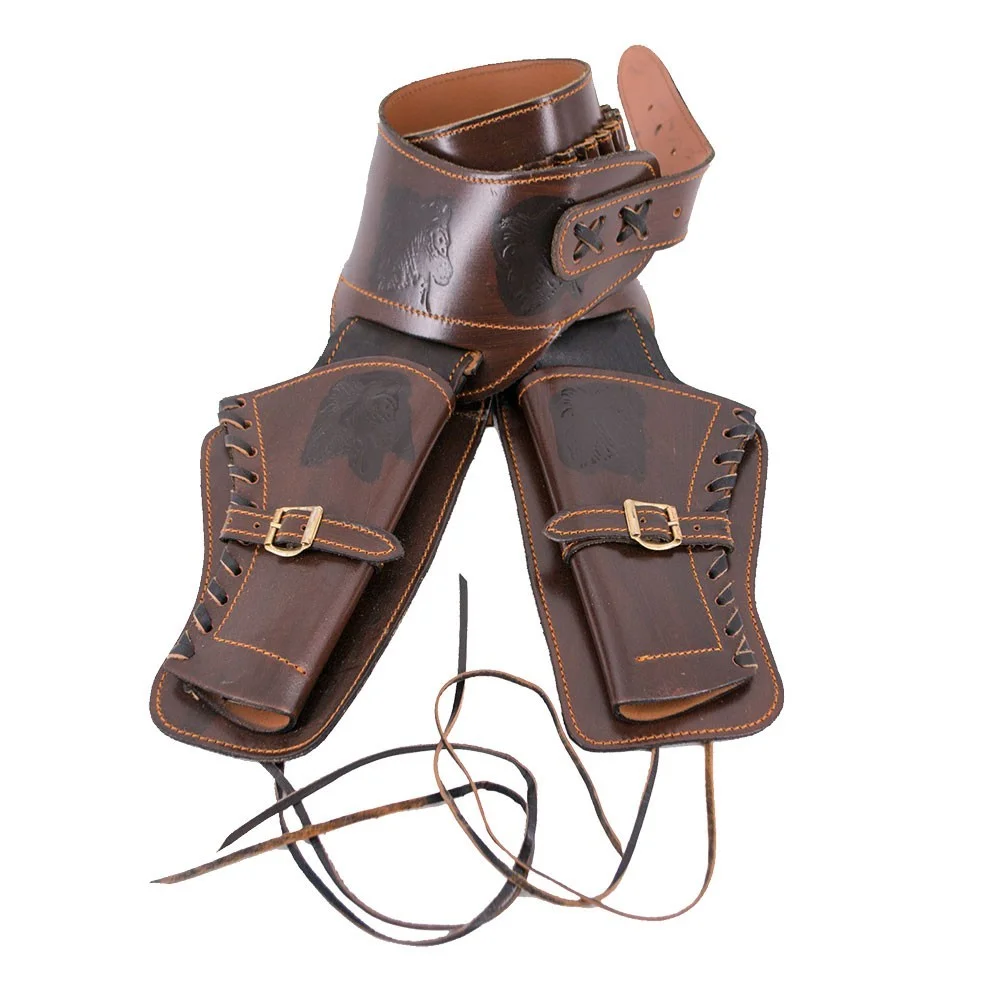 Western cinema turned revolver gunbelts into instantly recognizable cinematic symbols. Legendary directors like Sergio Leone, John Ford, and Sam Peckinpah understood the visual power of these accessories and used them to define characters and create unforgettable moments.
Western cinema turned revolver gunbelts into instantly recognizable cinematic symbols. Legendary directors like Sergio Leone, John Ford, and Sam Peckinpah understood the visual power of these accessories and used them to define characters and create unforgettable moments.
Films that immortalized gunbelts
Some scenes and characters became legendary thanks to the dramatic use of gunbelts:
- The Good, the Bad and the Ugly (1966): Clint Eastwood as “The Good” wears a crossed gunbelt that became his visual hallmark.
- The Magnificent Seven (1960): Each of the gunslingers displays different gunbelt styles, reflecting their personality.
- Pat Garrett and Billy the Kid (1973): Historical realism in the wardrobe included meticulously recreated gunbelts.
- The Wild Bunch (1969): The protagonists’ crossed gunbelts emphasized their hardened outlaw nature.
These films not only entertained: they visually educated generations about the aesthetic of the Old West, creating a visual code that endures to this day in popular culture.
How to choose the perfect revolver gunbelt
Selecting the ideal gunbelt depends on several factors you should consider according to your objectives and personal preferences.
Define your purpose
Before purchasing a gunbelt, ask yourself what you need it for:
- Historical reenactment: Look for exact replicas with historical documentation that guarantees authenticity in events and exhibitions.
- Collecting: Prioritize the quality of materials and fidelity to the original design, including specific brands and details.
- Cosplay and themed events: You can opt for visually striking replicas even if they are not 100% historically accurate.
- Photography and cinema: Visual appearance is a priority; consider the finish and how it will look on camera.
Check leather quality
Genuine vegetable-tanned leather is fundamental for a durable gunbelt. Check these aspects:
- Uniform thickness: The leather should be between 2.5 and 3.5 mm thick to balance flexibility and strength.
- Reinforced stitching: Check that tension points are sewn with high-strength waxed thread.
- Natural finish: Quality leather can be dyed but must retain its natural texture without plastic coatings.
- Controlled flexibility: It should be able to bend without cracking but maintain its shape when loaded.
Compatibility with your replica revolver
Make sure the gunbelt loops match the caliber of your replica revolver cartridges:
| Historical Caliber | Cartridge Diameter | Compatible Revolvers | Historical Use |
|---|---|---|---|
| .45 Long Colt | 11.5 mm | Colt Peacemaker, Remington 1875 | Cavalry and civilians |
| .44-40 Winchester | 10.9 mm | Colt Frontier, various models | Cowboys and ranchers |
| .38 Special | 9 mm | Colt Police Positive, S&W small models | Urban police |
| .44 Magnum | 11.2 mm | Later models (modern replicas) | Big game hunting |
- Compatibility of historical calibers
-
- .45 Long Colt (11.5 mm): Compatible with Colt Peacemaker and Remington 1875. Used by cavalry and civilians in the Old West.
- .44-40 Winchester (10.9 mm): Compatible with Colt Frontier and various models. Preferred by cowboys and ranchers for its versatility.
- .38 Special (9 mm): Compatible with Colt Police Positive and small Smith & Wesson models. Adopted by urban police.
- .44 Magnum (11.2 mm): For later models and modern replicas. Designed for big game hunting.
Care and Maintenance of Your Leather Gunbelt
A well-cared-for gunbelt can last for decades, developing a unique patina that enhances its aesthetic and historical value. Leather is a living material that responds to the treatment it receives.
Regular cleaning
Dust and dirt can accumulate in the loops and seams. To keep your gunbelt in optimal condition:
- Gentle brushing: Use a natural bristle brush to remove dust from the surface and loops.
- Slightly damp cloth: Clean the surface with a cloth barely moistened with water, never soaked.
- Natural drying: Allow to dry completely at room temperature, away from direct heat sources.
- Frequency: Perform this cleaning after each intensive use or every 2-3 months if on display.
Leather conditioning
Leather needs to maintain its flexibility and water resistance. Apply these treatments periodically:
- Neatsfoot oil: The traditional treatment used since the 19th century, it penetrates deep into the fibers.
- Natural beeswax: Provides protection against moisture and a subtle satin finish.
- Application frequency: Every 3-6 months depending on storage and usage conditions.
- Method: Apply a small amount with a soft cloth, rub in circles, and allow to absorb for 24 hours.
Proper storage
When not using your gunbelt, store it correctly to preserve its shape and condition:
- Hung position: Use a hanger or hook to prevent creases and deformations.
- Controlled environment: Stable temperature between 15-25°C and relative humidity of 40-60%.
- Protection from sunlight: UV rays can discolor and dry out leather prematurely.
- Avoid plastic: Store in breathable fabric covers that allow air circulation.
The Cultural Value of Gunbelts in American History
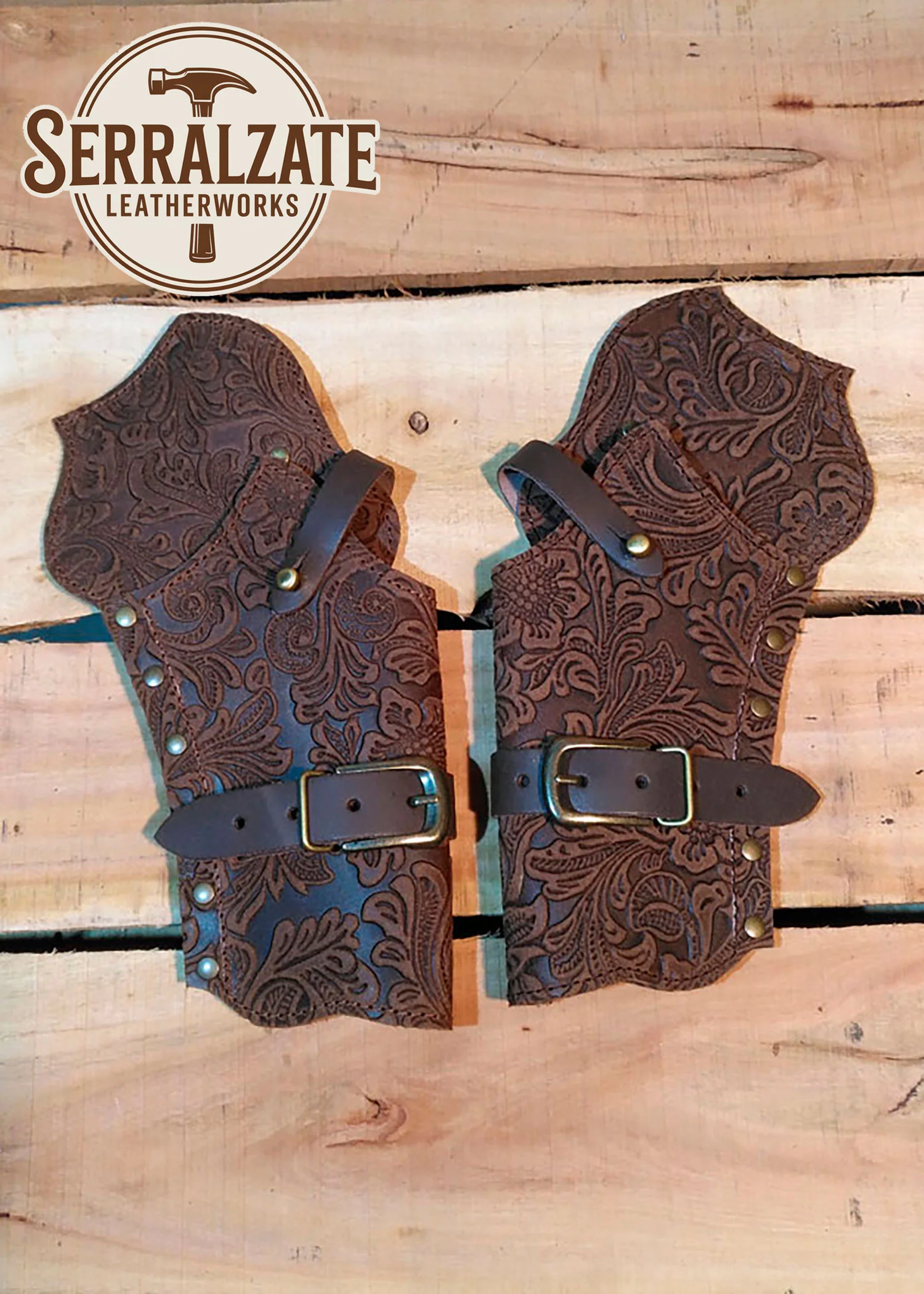 Beyond their practical function, revolver gunbelts represent a fascinating chapter in American history. During the westward expansion, these accessories accompanied explorers, settlers, soldiers, and outlaws in one of the most dramatic transformations of a territory.
Beyond their practical function, revolver gunbelts represent a fascinating chapter in American history. During the westward expansion, these accessories accompanied explorers, settlers, soldiers, and outlaws in one of the most dramatic transformations of a territory.
Symbol of the American Frontier
The loaded gunbelt represented self-sufficiency, an essential quality in territories where formal law barely existed. Carrying enough ammunition could mean the difference between surviving a bandit attack, defending against wild animals, or hunting for food for days.
In isolated communities, skill with a revolver and the preparedness symbolized by a well-supplied gunbelt were respected and admired. It was not just about violence: it was about preparation, personal responsibility, and the ability to protect family and property.
Evolution of design
Gunbelts evolved along with armament technology. Early models for percussion revolvers had to carry powder, bullets, and primers separately. With the advent of the metallic cartridge in the 1870s, gunbelts became simpler and more specialized.
This evolution reflects the rapid industrialization and modernization of the United States during the last third of the 19th century, when the wild frontier began to transform into organized territories and, finally, into states integrated into the Union.
Historical Reenactment: Live the Old West Experience
The historical reenactment of the western period has experienced notable growth in recent decades. Enthusiasts from all over the world gather at events where they recreate battles, scenes of daily life, and emblematic moments of the conquest of the West.
Reenactment events and associations
Participating in these activities requires attention to historical detail, and authentic gunbelts are crucial elements of the costume. Historical reenactment associations establish rigorous standards to ensure accuracy in uniforms, weapons, and accessories.
At these events, you can:
- Participate in battle reenactments: From Civil War clashes to skirmishes with native peoples.
- Experience period camps: Experience daily life as it was in the 19th century.
- Historical shooting competitions: Using functional replicas of antique weapons with strict safety regulations.
- Exchange knowledge: Learn traditional craft techniques, horsemanship, and survival in the wild territory.
Preparing your re-enactor equipment
To get started in western historical reenactment, you’ll need more than a gunbelt and a replica revolver. A basic complete equipment includes:
- Period clothing: Canvas pants, cotton shirt, vest, hat appropriate to the period and region.
- Historical footwear: Leather boots with sloped heels, characteristic of the cowboy style.
- Revolver holster: Compatible with your specific replica model, also in traditionally tanned leather.
- Complementary accessories: Neck scarf, spurs (if you ride a horse), belt with a period buckle.
Gunbelts and Revolvers: An Investment in Tangible History
Acquiring authentic replicas of gunbelts and revolvers is not simply buying decorative accessories. It is investing in pieces that directly connect with a fascinating historical period, preserving traditional artisanal techniques and keeping cultural memory alive.
Educational value
These replicas serve as exceptional educational tools. Museums, schools, and cultural centers use them to illustrate how people lived, worked, and defended themselves on the American frontier. Touching and examining an authentically recreated gunbelt provides a tactile and immediate understanding that no photograph or description can match.
Preservation of traditional crafts
The demand for high-quality replicas keeps alive artisanal trades that might otherwise disappear. Saddlers specializing in 19th-century techniques pass on their knowledge to new generations, ensuring that these skills are not lost in the era of mass industrial production.
Each handmade gunbelt represents hours of meticulous work: cutting the leather according to historical patterns, hand-stitching or using antique pedal machines, shaping the loops, applying natural dyes, and treating the leather with traditional methods. It is craftsmanship in its purest form.
Compatibility between gunbelts and pistol belts
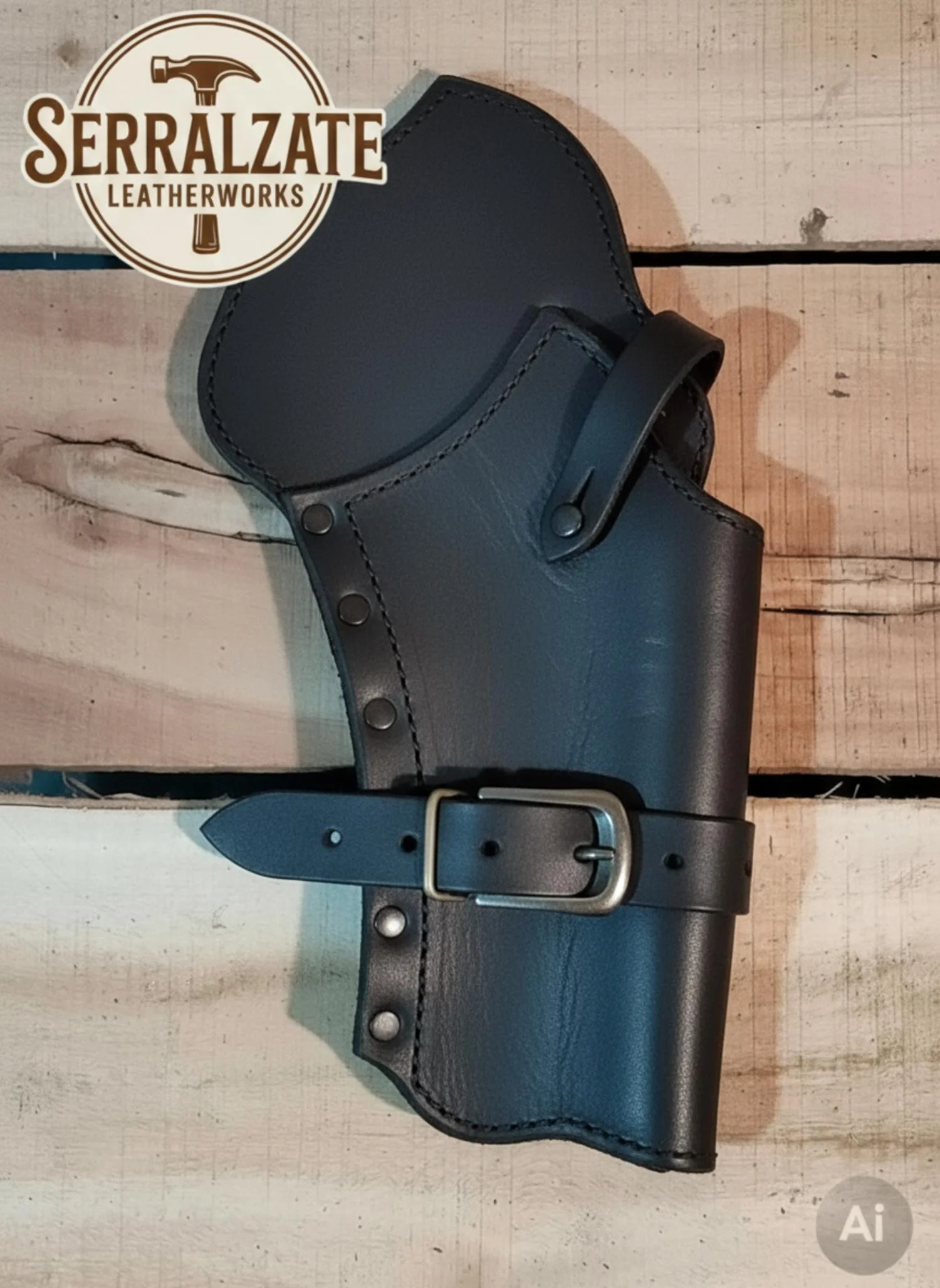 Revolver gunbelts are designed to complement pistol belts, creating an integrated system for carrying weapons and ammunition. This combination is not only practical but also aesthetically coherent.
Revolver gunbelts are designed to complement pistol belts, creating an integrated system for carrying weapons and ammunition. This combination is not only practical but also aesthetically coherent.
Integrated systems
A complete Old West gunslinger outfit typically included:
- Main belt: Made of thick reinforced leather, capable of supporting the weight of the revolver and gunbelt without deforming.
- Revolver holster: Placed at hip height, with an angle that allowed for a quick and natural draw.
- Integrated gunbelt: Sewn directly to the belt or designed to slide over it and attach with loops.
- Characteristic buckle: Frequently decorated or personalized, it became a personal identifier for the wearer.
This system distributed the weight evenly around the waist, allowing the equipment to be carried for hours without excessive discomfort, essential for those who spent days on horseback or patrolling extensive territories.
Differences between rifle and revolver gunbelts
Although both fulfill the function of carrying ammunition, rifle and revolver gunbelts present significant differences in design and use.
Design and capacity
Revolver gunbelts are characterized by:
- Smaller loops: Adjusted to the diameter of revolver caliber cartridges (.38, .44, .45).
- Horizontal distribution: Cartridges are carried vertically in a single or double row around the waist.
- Moderate capacity: Between 12 and 36 cartridges depending on the model.
- Lightweight: Designed not to hinder rapid movement.
For their part, rifle gunbelts generally include:
- Longer loops: To accommodate larger rifle cartridges (.30-30, .44-40, .45-70).
- Bandolier configuration: Frequently worn crossed over the chest to better distribute the weight.
- Greater capacity: Can carry 50 or more cartridges in some designs.
- More robust construction: To support the additional weight of rifle ammunition.
Western Aesthetics in Contemporary Popular Culture
The interest in the aesthetic of the Old West transcends historical reenactment and collecting. Fashion designers, film directors, video game developers, and artists from various media continue to draw on these iconic visual elements.
Western in modern fashion
Elements of western attire, including stylized gunbelts, have appeared on high fashion runways. Designers interpret these accessories with contemporary materials and modern finishes, but maintain the recognizable silhouette that evokes the freedom and rebellion associated with the American West.
Video games and digital media
Titles like “Red Dead Redemption” have introduced detailed western aesthetics to new generations. Developers dedicate significant resources to digitally recreate every element of period equipment, including gunbelts and revolvers with astonishing historical accuracy.
This exposure in interactive media has rekindled interest in physical replicas, creating a new generation of collectors who discovered their passion for the Old West through screens but seek tangible and authentic experiences.
Legal Considerations When Acquiring Weapon Replicas
Although non-functional replicas of revolvers and gunbelts are legal in most jurisdictions, it is important to know the specific regulations in your area before purchasing these products.
General regulations
Decorative replicas that cannot fire real ammunition are generally considered collectibles or decorative items, not weapons. However:
- Public transport: May be regulated even for replicas; always transport in closed, discreet cases.
- Public events: Verify the necessary permits to carry replicas at historical reenactments or conventions.
- Identifying marks: Some jurisdictions require replicas to have visible marks that distinguish them from real weapons.
- Minimum age: Sales may be restricted to adults in certain places.
Always consult with local authorities or historical reenactment associations who know the specific regulations applicable in your region.
Clarifying doubts about Wild West weapon replicas
What are the most accurate replicas of Wild West weapons?
The most accurate replicas of Wild West weapons are those manufactured by Denix, known for their great detail and quality, especially emblematic models such as the Colt Single Action Army revolver (Colt 45 Peacemaker) and the Winchester 1873 rifle. These replicas are made of metal and wood, with functional mechanisms for historical reenactments and collecting, faithfully maintaining the original dimensions and characteristics of 19th-century weapons.
Among the most outstanding are:
- Colt Single Action Army (Peacemaker) 1873 revolver, an iconic symbol of the American West.
- Winchester Model 1873 rifle, valued for its accuracy and effective range.
- Other very well reproduced models include the Deringer revolver and the Sharps 1874 rifle, both with great detail and historical accuracy.
These replicas also usually include original accessories such as brass bullets, holsters, and leather belts, seeking a complete and authentic experience for collectors and reenactors.
In summary, Denix replicas are considered the most accurate in terms of design, materials, and operation of classic Wild West firearms.
What characteristics make Wild West weapon replicas unique?
Wild West weapon replicas are characterized by being faithful reproductions of classic original models, manufactured with materials such as high-quality metal and wood that imitate the appearance and details of historical weapons. Their design is based on emblematic models such as the Colt Peacemaker 1873 revolver or Winchester rifles, including realistic finishes, engravings, and mechanisms that simulate the originals, but without real ballistic function. They are ideal pieces for collectors, historical reenactments, exhibitions, or cosplay, capturing the aesthetic essence and character of the Far West. In addition, many replicate specific characteristics such as size, weight, and visual details that make them authentic in appearance and feel, even if they are not functional weapons.
What are the most popular replicas among Wild West weapon collectors?
The most popular replicas among Wild West weapon collectors are mainly:
- Colt Single Action Army (Peacemaker) revolver: The most emblematic and sought after, famous for its use by cowboys, law enforcement, and outlaws, recognized for its durability and classic design.
- Winchester 1873 rifle: Known as “the rifle that won the West”, highly valued for its history, lever design, and association with western figures.
- Smith & Wesson Model 3 revolver: Popular for its accuracy and firepower at that time despite its cost and mechanical complexity.
- Remington Army revolver (and its conversions to cartridges like the .46 rimfire): Also valued among collectors and enthusiasts for its historical importance.
These replicas stand out for their authenticity, quality finish, and historical connection, being coveted pieces for collections, decoration, and themed Old West settings.
What are the differences between Wild West weapon replicas and the originals?
Differences between Wild West Weapon Replicas and Originals
- Originals: They were primarily manufactured with metals such as steel or iron, solid mechanisms, and durable moving parts, designed for real use and daily wear and tear.
- Replicas: They can be made of lighter metals or alloys such as zinc to imitate the weight and appearance, but not always the strength. Some modern replicas (airsoft, decorative) use plastic in certain parts to reduce costs.
- Visual Details: Replicas usually imitate the engravings, marks, and finishes of the originals, but in historical models, the marks and serial numbers may be absent or fictitious.
Function and Use
- Originals: They fire real ammunition, with single or double-action mechanisms, and are designed to withstand the pressure and recoil of a powder cartridge.
- Replicas: They do not fire real ammunition. They can be blank-firing pistols (fire powder cartridges without a bullet), airsoft (fire plastic pellets), or simply decorative and non-functional. Internal mechanisms are usually simplified or adapted for their specific purpose.
- Maintenance: Originals required constant maintenance (cleaning, oiling, spring inspection), while replicas do not need that level of attention, except for those designed for use in recreational shooting competitions.
Ergonomics and Safety
- Weight and Balance: Replicas usually imitate the weight, but can alter the center of gravity, especially if different materials are used.
- Safety: Replicas usually incorporate mandatory safety elements to avoid confusion with real weapons (e.g., orange tip in airsoft, non-functional mechanisms in decorative ones).
Authenticity and Historical Details
- Originals: The marks, engravings, and serial numbers are authentic and allow the origin and history of the weapon to be traced.
- Replicas: They can reproduce the aesthetic details, but often omit or stylize certain elements to facilitate production or adapt to regulations.
Visual Summary
| Feature | Originals | Replicas |
|---|---|---|
| Materials | Steel, iron, wood | Alloys, zinc, plastic, wood |
| Functionality | Fires real ammunition | Does not fire real ammunition (blank, airsoft, decorative) |
| Mechanism | Complete, realistic | Simplified or adapted |
| Historical Details | Authentic engravings, serial numbers | May be missing or fictitious |
| Use | Real (defense, work) | Collection, reenactment, decoration |
| Safety | No special distinctive marks | Orange tips, non-functional mechanisms |
- Differences between originals and replicas
-
- Materials: Originals in steel, iron, and wood. Replicas in alloys, zinc, plastic, and wood.
- Functionality: Originals fire real ammunition. Replicas do not fire real ammunition (blank, airsoft, or decorative).
- Mechanism: Originals with complete and realistic mechanism. Replicas with simplified or adapted mechanism.
- Historical Details: Originals with authentic engravings and serial numbers. Replicas may have fictitious or missing details.
- Use: Originals for real use (defense, work). Replicas for collection, reenactment, and decoration.
- Safety: Originals without special distinctive marks. Replicas with orange tips and non-functional mechanisms.
In conclusion, replicas seek to imitate the appearance and, in some cases, the tactile sensation of original weapons, but differ in materials, function, historical authenticity, and intended use.
